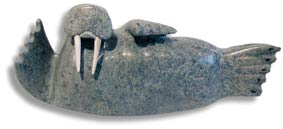


|
How To Preserve Your Art Collection It's important to look after your art and preserve it for years to come. Inuit Art comes in many forms so it’s vital to know the best way to look after each particular piece. Stone SculpturesInuit stone sculptures can be large and heavy, or light and dainty, either way, avoid displaying such sculptures on high shelves or pedestals. Instead, choose a low shelf or surface to display them on and minimise the risk of them ever falling from a height. For the same reason, avoid displaying near doors or air vents or anywhere it could easily be knocked to the floor. Stone is a durable art material so can be kept in direct sunlight and fluctuating temperatures are not that much of a problem. Inuit carvings are often referred to as ‘soapstone carvings’, but they are made from a great variety of different stones, often dependant on the region the sculpture was carved in. Stone is durable but can be easily scratched and damaged so when moving it around, remove all rings, watches, necklaces, belt buckles and other jewellery. Stone sculptures made from soapstone will need to be handled with slightly more care than carvings from harder types of stone. Wear non slip gloves such as latex gloves to support it and keep it clean. Use a soft cloth to keep it free from dust and if your sculpture has a lot of texture and crevices use a paintbrush to dust away any dirt that has become embedded. Prints, Drawings and Paintings Prints should be displayed away from direct sunlight or artificial light. Light can fade pigments and cause paper and textiles to discolour or become brittle. Choose a location with a steady temperature, so avoid hanging near radiators and windows. Humidity can be very bad for this type of art so avoid bathrooms and kitchens. Consider having prints professionally framed. ‘Conservation Level Framing’ helps to preserve artwork by protecting it against mould, insects, heat and humidity, light and UV rays, and air pollution. Ivory, Bone and Antler Sculptures and Jewellery It is very important that these pieces are kept away from doorways, radiators, windows, anywhere that there is likely to be rapid or varied fluctuations in temperature or humidity. Ivory in particular is very sensitive to changes in relative humidity. In changing humidity ivory swells and shrinks, causing potentially cracking and warping. Display these pieces far away from any potential spills. Bone and antler are quite porous, and absorb dirt, dust and liquids easily, if they come into contact with coloured materials they are likely to stain. To clean these pieces, lightly dust with a soft brush. Ivory is not as porous as bone and antler so can be lightly washed with cotton wool, a little water and mild soap. But it is still quite porous so after rinsing, ensure the surface is dried within 15-20 seconds using some more cotton wool. Never soak bone or ivory in water and if you notice your bone or ivory yellowing, don’t worry this happens naturally and adds to the piece. Fur For Inuit art with fur elements, insects are the biggest threat to preservation of this type of art, if this becomes a problem for you, freezing the fur is an effective way to combat this. Protecting Your Art and Yourself The value of art is rocketing, and in this period of economic uncertainty, art is seen as an attractive investment. When buying, make sure you are supplied with a certificate of authenticity and make sure you buy from a reputable source. Verify the seller and if you have any doubts you can search stolen art databases to ensure any potential purchases are legitimate. Unfortunately, art is increasingly catching the attention of criminals, the FBI estimate a worldwide loss of up to $6 billion annually from art and antiquity theft. Personal collectors should consider ways to increase the security around their art purchases and make sure their home contents cover their collection. Art is unique in that valuables are displayed and not locked away. A balance between display and security has to be found. With paintings and prints the method of hanging can help secure it. Prints can be fixed to the wall using an interlocking hook system that makes it difficult to simply lift it off the wall. This also protects it from earthquakes and accidents. 
|